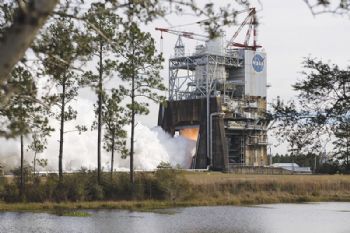
On 16 January, NASA and Aerojet Rocketdyne hot-fired an RS-25 engine in a test that marked another milestone towards the first crewed flight of the agency’s Space Launch System (SLS), while laying the groundwork for production of the heavy-lift launch vehicle’s main propulsion system.
The 365sec test at NASA’s Stennis Space Center in Mississippi qualified the controller (in effect the brain of the engine) for the third of four RS-25 engines that will power the SLS first stage on Exploration Mission-2 (EM-2), which will send astronauts to near the moon in the early 2020s.
It will be mankind’s first foray beyond low Earth orbit in nearly 50 years.
Also on the test engine was an additively manufactured component designed to dampen engine vibrations that could create stability issues during flight.
The ‘pogo accumulator assembly’ — the engine’s largest additively manufactured component to date — has now performed successfully on two successive RS-25 hot-fire tests (the first test was on 13 December 2017).
Eileen Drake, Aerojet Rocketdyne’s CEO and president, said: “Aerojet Rocketdyne is playing a vital role in the nation’s effort to expand the frontiers of mankind.
“This test is the latest example of our steady progress, not only towards EM-2 but also towards putting the nation’s exploration programme on a sustainable path for the future.”
Additive manufacturing is a key element of Aerojet Rocketdyne’s plan to reduce the manufacturing costs of future versions of the RS-25 by 30%.
The RS-25 engine is based on the main engine that powered NASA’s Space Shuttles into orbit. Future versions will use design simplifications and modern manufacturing processes — such as additive manufacturing — to minimise costs.
The RS-25 programme has 16 engines left in its ‘inventory’ from the Space Shuttle programme; these are currently being re-purposed for SLS, which will make its debut in 2019 carrying an un-crewed version of NASA’s Orion spacecraft.
These legacy engines are being upgraded and modernised for the first four flights of the SLS.
Thrust is being increased from 491,000 pounds on Space Shuttle missions to 512,000 pounds for SLS.
The new controller weighs less and has far more processing power than previous versions.